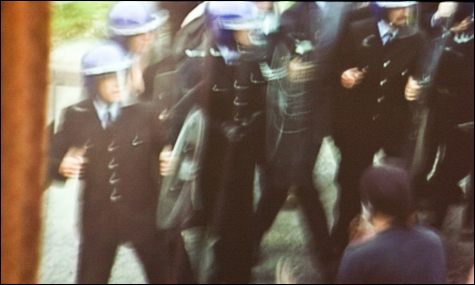
BRING POPCORN: Jeremy Deller’s video is well worth the hour-long viewing time.
|
|
“The World as a Stage” Institute of Contemporary Art, 100 Northern Ave, Boston | Through April 27
|
Imported from London’s Tate Modern, where it premiered last fall, the Institute of Contemporary Art’s new “The World As a Stage” has one terrific piece: London artist and 2004 Turner Prize winner Jeremy Deller’s infrequently seen 2001 video The Battle of Orgreave, which documents his large-scale re-enactment of an infamous clash during a British miners’ strike. The re-enactment is part community therapy, part exorcism; the resulting video is tense and visceral and heartbreaking.
It’s also an hour long. I know it’s difficult to devote that much time to a single video in a small uncomfortable museum gallery, but here’s how to do it: bring a pillow, sneak in popcorn, and skip the rest of the show.
The Battle of Orgreave begins with jarring, close-up, re-enactment footage of miners grappling with police in riot gear, then shifts to a peaceful meeting hall where a coordinator prepares a room full of men to re-create the 1984 incident. The 2001 re-enactment involved hundreds of performers, among them former miners who participated in the original strike and their families. Part of the drama is the question of what might happen when you bring hundreds of people together and churn up their really bad memories. “If you’re watching this, Mrs. Thatcher,” one former miner says, “thank you for the future of my children.”
In 1984, British prime minister Margaret Thatcher’s Conservative government sparked a strike by union miners of the state-run coal industry by announcing plans to close 20 pits and eliminate 20,000 jobs. Conservatives argued that the industry was unprofitable and productivity low and that the miners made irresponsible wage demands. Deller’s sympathies are with the miners. His video argues that the Thatcher government deployed cruel tactics to break the rival political power of the unions.
Several thousand striking miners showed up at Orgreave in South Yorkshire one June day in 1984 to stop trucks from bringing coal from a processing plant there to steel factories. Thousands of police officers came to stop the miners. It turned into a brawl. The miners were routed; eventually they lost the strike, as well. The mines closed, and that devastated many of the communities around them. Watching the re-enactment with knowledge of the outcome, it’s still hard not to hope that the miners will win, that somehow history can be rerouted, that it all might go better for them this time around.
Re-enactment of great moments in lefty history has become a bit of a trend in art. Providence’s Mark Tribe restaged a 1971 Howard Zinn anti–Vietnam War speech on Boston Common last July. In 2004, John Malpede re-enacted Robert Kennedy’s famed 1968 tour of poor Kentucky communities. Deller’s film is one of the best of the bunch. It’s closer in power and polish to Paul Greengrass’s 2002 vérité-style film Bloody Sunday, a re-creation of the infamous 1972 Derry massacre of Irish protesters by British soldiers.
It surely helps that, even though Deller is the artist of record, he contracted Mike Figgis (Leaving Las Vegas) to direct The Battle of Orgreave. The film cuts back and forth between the re-enactment and reminiscing miners to develop an oral, people’s history that often contrasts with the official version. In one instance, the video presents the text of an apology the BBC made in 1991 for switching the order of news footage to suggest that miners threw stones at police before police made their initial charge, when in fact the police charged first.
On a grassy field near the site of the original clash, miners chant, “The miners/United/Will never be defeated!” Police drum on their shields. Miners throw (fake) bricks, but they’re outgunned by police with their helmets, shields, clubs, and charging horses. It’s mediæval warfare. Police funnel the miners into the narrow streets of the village. Mounted police scatter picketers. Officers on foot charge forward, clubbing strikers. The miners yell and kick and punch and hurl stones. A car burns. “We weren’t victims all the time,” says one codger. “We gave them a bit back sometimes. In fact, we sometimes gave them a bit back first.” Thatcher, in a recording about the strikes from the time, proclaims, “Violence and intimidation here are the enemy of democracy.”
Most heartrending are the recollections of a man whose father worked in coal pits for 46 years, whose brother was a miner, and who himself was a miner before he gave it up to become a policeman. He wound up participating in the Orgreave clash as a uniformed officer, and he admits to getting “pissed off” when a fellow officer was badly wounded by a brick. But later he says, “One of the reasons I joined the police was that I wanted to do something for the community I came from. And thanks to Margaret Thatcher I did — I helped destroy it.”